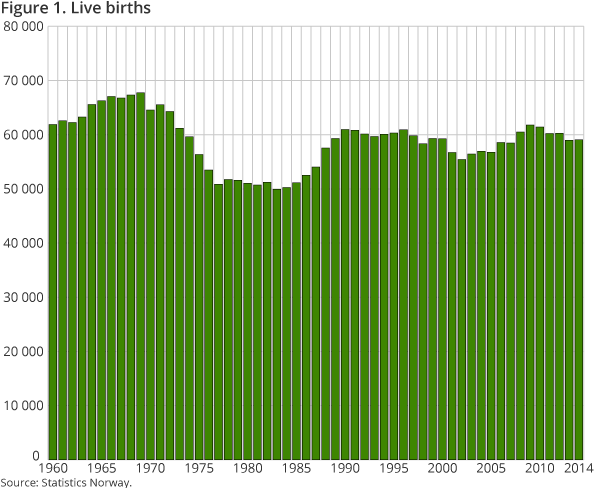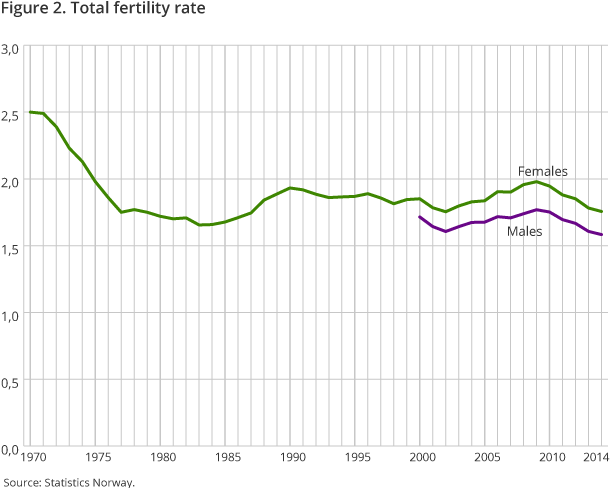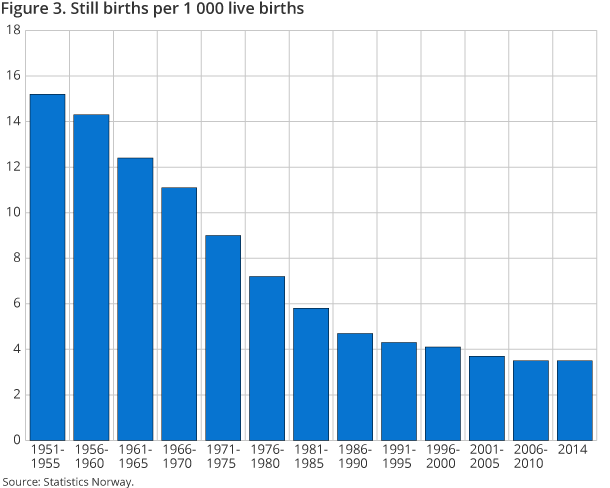Content
Published:
This is an archived release.
Gradual decline in fertility continues
A total of 59 100 children were born in 2014, which is about the same as in 2013.This gives a total fertility rate (TRF) for women of 1.76; a slight decline compared with 2013. In 2009, the total fertility rate was 1.98. Since then, the fertility rate has declined.
| Live births | 2014 | 2013 | 2004 |
|---|---|---|---|
| Total | 59 084 | 58 995 | 56 951 |
| Boys | 30 370 | 30 138 | 29 192 |
| Girls | 28 714 | 28 857 | 27 759 |
| Total fertility rate | |||
| Women | 1.76 | 1.78 | 1.83 |
| Men | 1.58 | 1.61 | 1.67 |
| Age at first birth | |||
| Mother | 28.7 | 28.6 | 28.0 |
| Father | 31.3 | 31.3 | 30.8 |
| Cohabitation status of mother | |||
| Married | 25 495 | 25 553 | 27 326 |
| Cohabitation | 26 140 | 25 830 | 22 756 |
| Single | 7 449 | 7 612 | 6 869 |



The total fertility rate for men was 1.58 in 2014; a slight decline from 2013.
Highest fertility in the county of Rogaland
Fertility was highest in the county of Rogaland, with a total fertility rate of 1.90. The counties of Oppland and Buskerud had the largest increase in fertility compared with 2013. The lowest fertility rate was registered in the counties of Hedmark and Buskerud, with a total fertility rate of 1.64. The counties of Nord-Trøndelag and Finnmark had the largest decline in fertility, with a fall of 0.18.
Icelandic and Swedish women were the most fertile in the Nordic countries in 2013. The total fertility rate for Iceland was 1.93, followed by 1.89 for Sweden. Norway had a fertility rate of 1.76, while Finland had 1.75. Denmark had the lowest fertility rate at 1.67.
Most children born to cohabiting couples
A total of 26 100 of children born had parents who lived as cohabitees, and 25 500 were born to married couples. The majority of first-born children had cohabiting parents, at slightly above 50 per cent. The proportion of married parents increases with the number of children born. Forty- six per cent of second-born children had married parents.
The percentage of children born to cohabitees was highest in the county of Nord-Trøndelag. Fifty-eight per cent of the children born in this county were in this category. The county of Vest-Agder had the largest percentage of children born to married parents with 54 per cent, while the county of Finnmark had the largest percentage of children born to single mothers, with 24 per cent.
Age of birth is stable
The mean age at the first child’s birth was 28.7 years for women and 31.3 years for men. This is an increase of 0.1 year for women. For men, the mean age was unchanged compared to 2013. Women aged 31-34 years were the most fertile in 2014, and women aged 25-29 years therefore had the second highest fertility rate. Compared to 2013, the fertility rate has fallen for women below 30 and increased for women aged 30 and older.
Increase in stillbirths
Following several years of a decline, the number of stillbirths increased in 2014. A total of 207 stillbirths were registered, which is 41 more than in 2013. This is the highest since 2009, but despite the increase, the number of stillbirths is still one of the lowest in Europe.
Contact
-
Statistics Norway's Information Centre
E-mail: informasjon@ssb.no
tel.: (+47) 21 09 46 42
-
Espen Andersen
E-mail: espen.andersen@ssb.no
tel.: (+47) 92 61 00 46
-
Ane Margrete Tømmerås
E-mail: ane.tommeras@ssb.no
tel.: (+47) 91 99 29 62
-
Oppdrag befolkningsstatistikk
E-mail: befolkning@ssb.no
